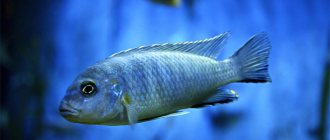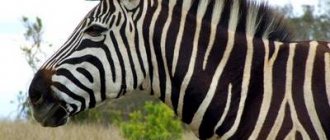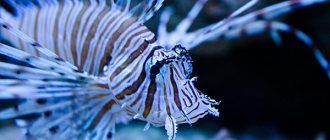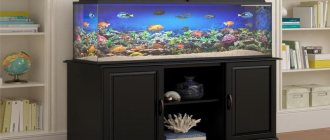African Lake Malawi is home to many cichlids. Among them there are studied and unstudied species. One of the most common and graceful cichlids belonging to the Mbuna group is Pseudotropheus zebra. According to the new classification, the fish belongs to the genus Maylandia, but the old name pseudotropheus, under which it is sold in stores and markets, has become very firmly attached to it.
This species of cichlid lives near rocky shores. They feed on algae that they scrape off rocks. The place you like is protected from encroachment by other fish. The stripes, for which the cichlid was called a zebra, are present only in individuals with classic coloring. In addition to such fish, there are individuals that do not have stripes, and their body color is orange or white. To preserve the pure breed, pseudotropheus is kept in a species aquarium so that they do not interbreed with other species.
Habitats
Metriaclima estherae, also known as Esther Grant's zebra, was described by Konings in 1995 and lives in Lake Malawi (Africa). The researcher named the species after Esther Grant, the wife of ichthyologist Stuart Grant.
Although a significant portion of the Metriaclima estherae population lives near Minos Reef, some individuals can be found in Meluluca (Mozambique, Africa). Like most other mbuna, the fish likes to live in rocky places where it can find its favorite algae, aufwux. Aufwux are long algae that grow on rocks. They may contain insect larvae, nymphs, crustaceans, snails, mites and other zooplankton.
It is worth noting that this cichlid is known in science under three different names. This is a problem that has not yet been resolved. When the species was first discovered, it was dubbed Pseudotropheus estherae and classified as part of the genus Pseudotropheus, which contained a subgroup of related fish called "Zebras".
Later it turned out that the fish are not so close, and in order to separate “Zebras” into a separate genus in 1984, it was decided to call them Mailandia. This name comes from the surname of the famous ichthyologist - Hans Mayland. But there were also problems with this name, as it did not meet some of the requirements provided for scientific names. Therefore, it was given the status of "nomen nudum", meaning that the name cannot be used as a scientific name. However, this issue is still under discussion.
In 1997, it was decided to rename the fish Metriaclima. As before, there were also problems with the name. In this case, the requirements for changing scientific names were not met. In particular, the designation is not submitted to official bodies for approval. Although Metriaclima is now the scientific name, all dissenters have the right to use the former name. Therefore, both late 20th century names, Metriaclima estherae and Maylandia estherae, are considered correct, and in some circles even Pseudotropheus estherae is used.
Description
Red zebras can live up to 10 years. Their body is elongated and resembles a torpedo in shape. The coloring of males and females is not the same; there are several different colors: males of the “red-blue” breed are colored light blue with faint vertical stripes and 4-7 round dots near the anal fin. The fry of this variation are easiest to distinguish from each other - males are born dark brown, and females are pale pink.
Males of the "bright red" breed can have not only red coloring, but also red-orange without any vertical lines. Their fry are born with the same coloring as the female, but after the males reach 6 cm in length, they begin to change color.
There is also a breed of “albinos”, but they are extremely rare in the wild. Females can be yellow, orange, or orange with dark speckles. Also, they have up to three large points near the anal fin.
Appearance
Pseudotropheus zebra differs from most cichlids in its appearance:
- Dimensions. An adult reaches a length of about 15 cm.
- The body shape is slightly elongated. The sides of the body are slightly flattened.
- The head is massive, the eyes are large. There is a fatty bump on the forehead - this is a special feature characteristic exclusively of males. The lips are thick.
- Fins. Dorsal – long, but not high, extending from head to tail. Anal and abdominal - solid with rays.
- Color – has a lot of options. In total there are about 50 species of zebras of different shades. As they grow older, the color may change slightly. In the CIS countries, the blue pseudotropheus zebra has gained the greatest popularity. The main color is a combination of blue and blue shades. There are 7 to 9 dark stripes running along the body. Other common types of zebra: red, yellow, snowflake with a white color and a blue tint.
Sex differences. Depends on the type of pseudotropheus color. General differences:
- Females have a fuller body than males, but are shorter.
- The spots on the fins of females are darker; as a rule, they are colored yellowish.
Other differences depend on the subspecies of zebra.
Feeding the red zebra
Representatives of the species Metriaclima estherae are omnivorous aquarium fish, but they require plant products on an ongoing basis. Although zebras can feed on zooplankton in the wild, the majority of their diet should consist of vegetables or similar foods. They will be happy with any food of this kind, but in order for the body color to remain bright, it is necessary to add fortified food, spirulina, cyclops or any high-quality food for cichlids. Sometimes you can give your fish shrimp or brine shrimp nauplii. It is worth noting that zebras get fat very quickly, so you should not overfeed them.
In addition, Metriaclima loves algal fouling, so food costs will be lower than in the case of carnivorous cichlids. It is recommended to feed the fish more often, but in small portions that will be quickly absorbed and will not spoil the water. The diet requires vitamins and animal food, but you should not overdo it with proteins because the fish may suffer from bloating.
In the following article you can learn about the feeding behavior of Metriaclima and their differences from other mbuna.
What to feed the black-striped cichlid
The basis of zebra cichlazoma nutrition is live and plant food in equal proportions. Of course, the cichlid is a predator and will always prefer to eat live food. But such an imbalance in the diet can lead to decreased immunity and obesity in the fish, followed by problems with internal organs. Therefore, it is recommended to alternate feeds.
- live: bloodworms, tubifex, pieces of shrimp or pollock fillet - can be fresh or frozen;
- vegetable: scalded lettuce leaves, cabbage, specialized dry mixtures, which contain vitamins and elements to maintain color.
Adults should be fed cichlase once a day. The diet can be changed during the spawning period or after an illness.
Keeping a red zebra in an aquarium
Metriaclima estherae requires an aquarium of at least 250 liters in size with a length of 122 centimeters. If representatives of this species are not the only inhabitants of the aquarium, even more space will be required. Zebras are comfortable with fresh or slightly brackish water; the main condition is to ensure a constant flow of water along with its effective filtration. You should definitely add corals or sand to the aquarium - they will help keep the pH at a high level. You can also use gravel. Stones and driftwood are useful for building a large number of passages and places where fish could hide. This will help reduce the aggression of individuals and divide the territory. The red zebra loves to dig in the ground, so stones should be placed on top of the sand rather than buried inside.
Poor water quality will immediately affect the health of cichlids. Since the Red Zebra is sensitive to the composition of the water, it is necessary to change 30% of the water weekly (depending on the number of animals in the aquarium) and clean the walls of the aquarium every two weeks. If the fish show increased aggression, we can recommend changing the location of shelters and holes, which will lead to disorganization of the community and a new redistribution of the territory. Bloating in Malawian cichlids is a typical disease for these fish, characteristic of individuals whose diet is dominated by products of animal origin rather than plant products. Red Zebras suffer from many other diseases common to all freshwater fish.
general information
Many people dream of having a large aquarium with a wide variety of exotic creatures. After all, watching the peaceful life of amazing fish is so interesting that few people are ready to give up such pleasure. The presence of a tank with such creatures in the house brings a feeling of peace and tranquility to the interior.
Beginning aquarists are initially guided only by aesthetic characteristics, which often leads to disappointment, because animals cannot withstand new conditions and die en masse. Certain types of sea creatures require complex care and increased attention, so they often do not get along in an enclosed space and do not feel well. To avoid such consequences, it is enough to study in advance the intricacies of keeping aquarium fish, and also choose the most stable species.
To avoid serious mistakes in the aquarium business, it is necessary to study the characteristics of the intended pets
Before choosing fish, you need to pay attention to several important points:
- How much time will be devoted to the aquarium?
- What is the optimal size of fish?
- What color suits you?
- Aren't sea creatures too aggressive?
Once you answer these questions, you can start purchasing the right type. And in this case, it makes sense to consider the option of an aquarium zebra.
Necessary conditions of detention
The rivers flowing into Lake Malawi are high in various minerals. Due to this and the large amount of evaporation, the water in the lake has a high content of alkalis and minerals. The lake is known for its transparency and stability of many chemical indicators, such as pH. This makes it clear why it is necessary to monitor the water parameters in an aquarium with fish from Lake Malawi. The risk of ammonia poisoning increases with increasing pH levels, so you should never forget to change the water in your aquarium. If these requirements are not met, the fish may take longer to acclimate to changes in pH levels.
Hardness: 6-10° dH pH: 7.7 - 8.6 Temperature: 23 -28° C
General information
Frontosa, or Cyphotilapia frontosa, is a ray-finned fish from the Cichlid family, until recently the only representative of the genus. You can meet this gorgeous fish only in the African Lake Tanganyika. Despite its impressive size and the need for a large aquarium volume, it is one of the most popular cichlids.
This majestic fish has an attractive striped coloration and a distinct fatty bump on its head. In the aquarium, it is slow and imposing, for which it received the name – Queen of Tanganyika.
Great intelligence can be read in the gaze of these majestic fish.
Frontoses are distinguished by high intelligence; when kept at home, they quickly remember their owner, allow themselves to be fed by hand, and are allowed to be petted.
A scientific description of the species was given to the fish back in 1906 by the English ichthyologist George Albert Boulenger. During its history, the fish moved several times from one systematic group to another, until it became the only representative of the genus Cyphotilapia.
However, in 2003, a group of ichthyologists from Japan described another species - Cyphotilapia gibberosa, living mainly in the southern part of Lake Tanganyika.
Compatibility of zebra cichlids with other fish
This mbuna is not what you would call friendly. The best combination of individuals is 1 male and 2-3 females. If other types of nimble fish are used in the aquarium to reduce aggression, frequent water changes are necessary. Metriaclima estherae can be kept together with other less aggressive mbuna from Malawi, but only if they are of different sizes and are not similar in appearance, otherwise clashes or crossings with the formation of hybrids may occur, which is highly not recommended. Also, under no circumstances should zebras be kept together with Haplochromis, since zebras, like all mbunas, are very aggressive towards them.
Male red zebra on top and female below (photo by Michael Persson)
Diseases and prevention
How long pseudotropheus live depends on the conditions, but usually up to 5 years. They are hardy and have good health. The only common problem is injuries received during territorial fights. In order for wounds on the body to quickly heal, you should add salt (3 g per liter) and methylene blue (until the water turns pale blue) to the aquarium.
Less commonly, at home, “zebras” suffer from parasitic diseases: ichthyophthyriasis (the parasite lives under the skin) and Malawi disease (the digestive tract is affected). In the first case, to prevent the death of pets, malachite grun is dissolved in water, and the temperature is lowered by 5°C. In the second case, there is no cure or prevention, the fish dies.
Pseudotropheus are beautiful and unpretentious fish, suitable for a voluminous, green-rich aquarium. Watching their lives and relationships is great fun.
Reproduction
Red zebras can be bred in captivity. Puberty ends in fish when they reach a size of 7-8 centimeters. If the desired color has not yet appeared in the fish purchased for breeding, you need to take 7-10 pieces at once. To stimulate spawning, spawners should be fed a varied diet twice a day. They also need a calm atmosphere. If Red Zebras are not spawning, then most likely one of the fish is too aggressive and should be removed from the aquarium. The absence of aggressive fish creates a calm atmosphere that promotes the reproduction of Metriaquima.
The female lays 20 to 30 eggs and immediately hides them in her mouth until they are fertilized. The male spreads his anal fin, on which there are points similar to eggs, so that the female, confusing them with her eggs, also tries to hide them in her mouth. By doing this, she stimulates the male to release sperm and fertilize the eggs. Within 2-3 weeks at a temperature of 28°C, the fry are born. The juveniles feed on powdered dry food and Artemia nauplii. At first, the female protects her offspring. In the future, it will be easier for the fry to survive if there is a sufficient number of shelters in the aquarium. The coloring of the “red-blue” fish at first is similar to the coloring of the female. Males begin to change color when they reach 6 centimeters in length. Males of the "bright red" breed are born with a dark brown coloring, and females with a pale pink coloring.
Female red zebra (Metriaclima estherae) with eggs in her mouth (photo by kimonasandrews)
Larvae with yolk sacs (photo by Michael Persson)
—— www.ciklid.org/artregister/artreg_visa_art.php?ID=701 — Michael Persson https://www.flickr.com/photos/kimonas/503282602/in/photostream/ — kimonasandrews











